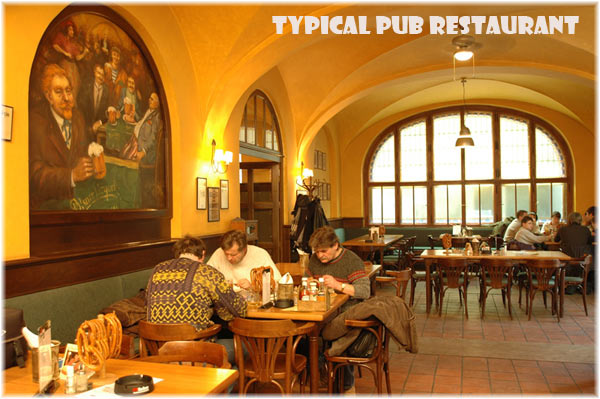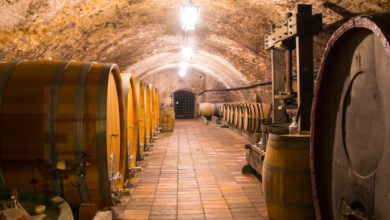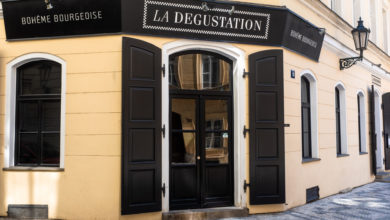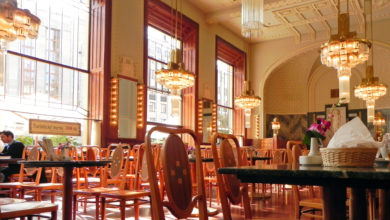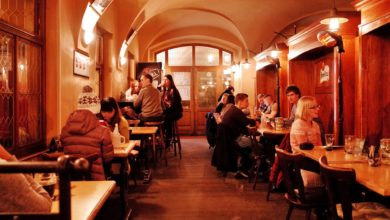Dining in Prague
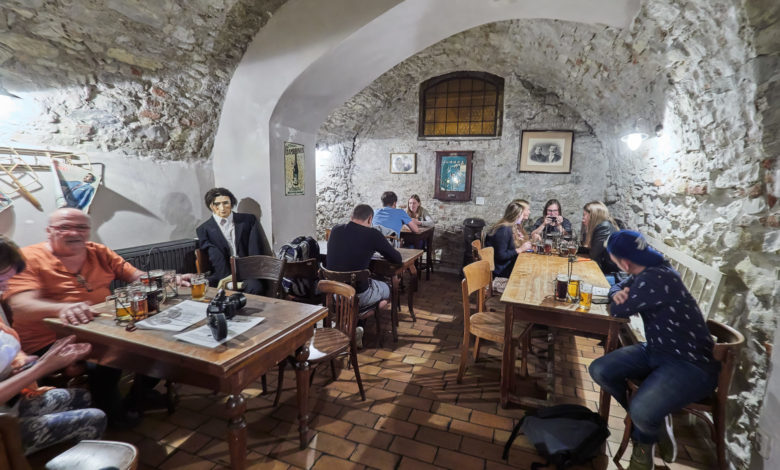
The atmosphere in the different restaurants will obviously vary, as will the standard of service. Most waiters will speak at least some English, although most younger waiters will have a good grasp of the English language. It won’t hurt to learn some of the local dialects for yourself, though, as this could be very useful when placing orders and appreciated by all of the staff.
Aside from the regular style restaurants, there are a few different types that should be sampled, such as:
Vinárny
These are wine restaurants, and they usually have a good selection of food but place a special emphasis on the great wine they serve. The interior is usually quite cosy and intimate, and the décor is usually quite classical with historical elements of Prague thrown in.
Pivnice / Hospody
These are more akin to pubs and taverns and usually only serve a limited food selection, usually centred around meat platters. What these taverns lack in food, they make up in high-quality beer, with an informal atmosphere like any other pub in the world.
Meal Prices and Tipping: The average price for a full meal in the centre of Prague is about 200 CZK to 300 CZK per person at cheaper restaurants; mid-range restaurants charge around 400 CZK to 700 CZK per person; and an expensive one will cost you anything from 700 CZK upwards, depending on the type of establishment. The price of a set meal at McDonald’s or KFC is around 130 CZK. Special lunch menus are available at many restaurants from 100 CZK. Generally, a 10% tip is appropriate if the service was good. Locals tend to leave lower tips at lunches and cheaper establishments, while at more expensive restaurants, a 10% tip is mostly given. Add the tip to the bill, rather than leaving the money on the table. Most restaurants accept credit cards.
Kavárny
These are basically cafes and are the perfect place to stop if you just fancy something small to eat, such as a pastry or a snack. Some do serve hot meals as well. There are also various other places to grab a quick bit of food, such as many fast-food outlets in the city.
One thing to watch out for is the hidden charge often levied by many restaurants, which usually comes in the form of a cover charge of about 50 to 100 CZK per person. Other places will charge for the use of condiments, while others leave appetizers on your table and neglect to mention that they are not free should you choose to eat them. When in pubs, waiters can often be seen heading around with trays of short drinks – these are not free, but their cost is usually rather small.
Breakfast
Most hotels will serve breakfast from the hours of 6 am through to 10:30 am, which should allow even the latest risers to feed themselves before heading out. Depending on the hotel, the breakfast can be either a simple selection of toast and jam or something a lot larger. The more expensive hotels usually serve more elaborate breakfasts with a selection of hot and cold food, but they also often charge extra for this. Often it is cheaper to head out and find a café to eat in.
Lunch and Dinner
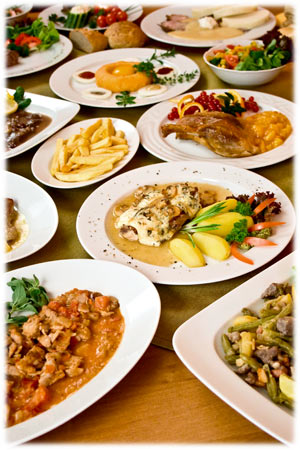
Most Czechs tend to eat their evening meal at around 7 pm on weekdays, as they want to get to bed early to be wide awake the next morning and ready for work. Most restaurants in the city do stay open later than this, though, with the average closing time being around 10:30 pm. This time is usually even later on weekends, though, as the citizens of Prague head out to eat and don’t have to worry about rising early the next morning.
Most restaurants have printed menu located near the entrance so that you can look over what they offer and decide whether anything takes your fancy. Most restaurants in the city also tend to have menus in English and German as well, so that they can capitalize on the booming tourist trade. The main items to be found on the menu will be studena jidla (cold dishes), polevky (soup), teple predkrmy (starters), ryby (fish), drubez (poultry), hotova jidla (main courses) and moucniky (desserts). In addition to these, a growing amount of restaurants are also offering set menus at lunchtime.
You can’t go wrong with a gorgeous slice of Prague Ham, which is a local speciality for starters. There are several different ways that this is served; it can come stuffed with cheese and horseradish in small sandwiches or served in slices with horseradish and cucumber garnish. However it is served, it will certainly provide a great start to any meal!
Many people in Prague are fond of having soup for either lunch or dinner. This usually comes in the form of a thick broth containing meat, vegetables and potatoes, although sometimes light bouillon soups can be found as well. One of the most popular styles is potato soup with mushrooms, which is also flavoured with carrots, onion, bacon, cabbage, parsley and spices. While many people like to have soup for starters in other cities, it is certainly classed as a main course in Prague!
Meat is the main component of nearly all Czech cuisine, and most of the favourite dishes contain a hearty helping of it. Prague Roast Beef – a joint stuffed with ham, egg, onion, and spices – is one of the favourites and boiled ham in plum, prune sauce, and goulash. Poultry is also very popular, and most restaurants will have a number of different poultry dishes. If the season is right, you will also find a lot of venison, duck, goose and wild boar on menus throughout the city.
Most visitors will quickly notice that many dishes are served with dumplings, and these are the traditional accompaniment to many different Czech dishes. They are either light and made from bread or heavy and made from potatoes: regardless of which you get, they will provide a delicious treat! The same can’t be said for vegetables, though, which have never been a popular part of the Czech diet. Generally, they are boiled and therefore often taste overcooked and not hugely appetizing. The most common vegetable dish is sauerkraut, which is cabbage cooked in fat, sugar and wine.
When it comes to dessert, the Czechs really know what they are doing. Such favourites as apple strudel, baked apple and plum dumplings are found throughout the restaurants in the city, and all are usually served with a generous dollop of cream. One of the most popular desserts is palacinka, which is ice cream (or cream) and fruit held together inside a pancake.
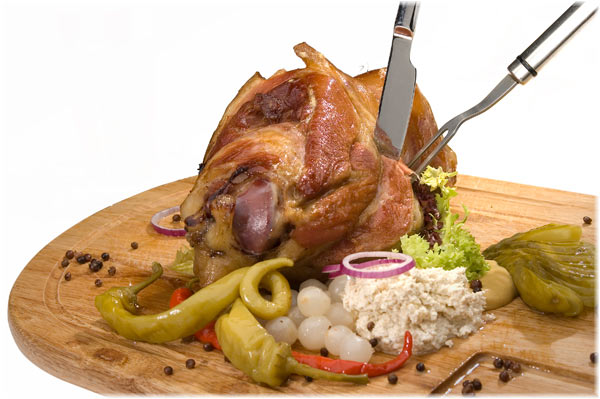
Smoking is something that is extremely common throughout the Czech Republic, and as such, it might be very difficult to escape the fumes in any restaurant that you visit although on a nice day you can do so by dining at one of the many restaurants with a terrace. It is not uncommon for diners to be seated at the same table as other guests on busy days – don’t be alarmed; this is a common practice. But nonsmoking law came to effect restaurants offer smoking and nonsmoking sections.
Snacks
Street stands can be found on almost every street corner in the centre of the city, and they provide the perfect option for a quick bite to eat when in a hurry. They serve a huge variety of different types of food, but one of the favourites is the potato pancake, which can be messy to eat! Roasted sausage, Wienerschnitzel, and open-topped sandwiches are also trendy choices for people in a hurry. If you want something a bit closer to home, then there are a number of fast-food joints located around Wenceslas Square, serving the kind of burgers that you find in every single city in the world. Ice cream can also be bought from a huge variety of different vendors.
Drinks
As you might expect, there are a huge amount of different places in the city that you can head to for a quick drink, with many of them also serving food as well. Due to the city’s beauty as a whole, you will be able to find a drinking spot looking out over any of the views that you want, therefore making for a fantastic break from the hustle and bustle.
Czech beer is known throughout the world and is centred on the city of Plzen, which was the originator of the pilsner style of lager. Locals will tell you that there is no other country in the world that brews beer with quite the same taste and quality since the highest quality water and hops are used throughout the production process. Some of the most famous lagers are Pilsener Urquell, Budvar and Staropramen, although many pubs also brew their own beer, which is often fantastic to sip on. You should be mindful that most Czech beer is very strong, so ensure that you drink sensibly.
Less well known than the beer brewed in the Czech Republic is the wine that comes from the region, so trying this when you visit will almost certainly be a new experience. The majority of the wine produced in the Czech Republic comes from Monrovia, which has a warm climate and therefore can produce a sweet grape with a distinctive taste. Many of the locals drink something known as Karlovy Vary, which is made from herbs. They also drink the stronger Stara Myslivecka. Many Czechs will be found drinking schnapps after dinner.
Vegetarian Cooking
It used to be the case that vegetarians were not really catered for in the city, but this has changed as Prague starts to become a more multicultural city. There are some vegetarian restaurants in the city, and most regular restaurants also have a selection of vegetarian food on their menu.
Czech Cooking
In the mind of nearly every Czech citizen, the national food is undoubtedly pork, cabbage and dumplings – something that tastes a lot better than it sounds! The dumplings are of the bread variety, meaning that they are light and dainty, while the cabbage is actually more akin to sauerkraut, which has a sour taste that complements the salty pork. It is a heavy dish to eat, laden with lots of fat – it isn’t a dish for health freaks – but is also incredibly nourishing and filling. The perfect accompaniment for this dish is, without doubt, a glass of real Czech beer.
Another popular meal is known as smažený sýr, which is essentially cheese fried in breadcrumbs. This was, in fact, pretty much the only vegetarian dish that was ever found in restaurants, but this has now changed thanks to the tourists visiting the city.
Sauces form a large part of the food that the people of the Czech Republic eat, and of these, the most popular is goulash. This is a sauce usually served with dumplings but can also often be found on other foods. Other popular sauces include tomato sauces, gravy with gherkins or cream with vegetables.
There are a number of other favourite foods eaten by the people of the Czech Republic, and most are found in the pubs that dot the landscape, usually being eaten accompanied by a glass of beer. These include pickled sausages, pickled herring, and salami served with vinegar. If these sound a little foreign to you, plenty of restaurants in Prague offer more international food, such as Italian and Mexican fare.
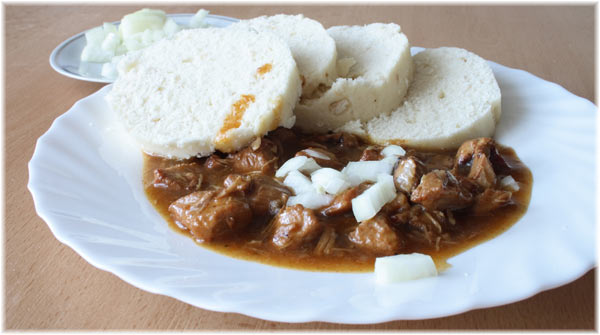
Late Night Snacks
Finding a bite to eat once standard restaurant hours are over is not always straightforward in Prague. The kitchen staff usually like to close down early, particularly on slower evenings, which means that, with the majority of venues, if you have not placed your order for food by 22:00, you may as well wait till breakfast. Many of the KFCs and McDonalds will sell food till at least 00:00. In Vinohrady, the Radost club FX is the best late-night choice for dining, with its’ cocktails, coffee drinks and vegetarian dishes till at least 03:00. Should you become stuck, you will discover an array of late-evening fast-food windows offering pizzas, snacks and gyros all through the night-time at the tram stop at Národní třída, adjacent to the Tescos in New Town.

